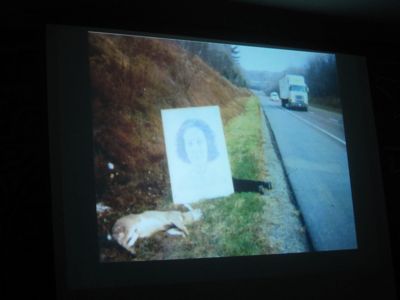This month, Stephen Wright from n.e.w.s. joined us from Paris. On Thursday night he was the guest at DAI and presented ‘Plausible Artworlds’, a collaborative project organized by Scott Rigby, Basekamp and Stephen Wright. Every Tuesday evening from 6 pm – 8 pm EST, in 2010, a group of people gather in the Basekamp space in downtown Philadelphia, while dozens of others from around the world join the potluck discussion over Skype. A kinda year-chat marathon, representative(s) of artists collectives or art-related groups present not their art “work” but the art-sustaining environment they have devised where art – as they understand that term – can thrive. Piggybacking on the sometimes capricious (but user-friendly and widely used) infrastructure of Skype, ‘Plausible Artworlds’ has sought over course of the year to compile a sizeable cross-section of “exhibits” – in the forensic sense of the term – attesting to the widespread existence of actual, multiple artworlds, substantively different from the mainstream variant, around the globe. The idea is to support alternative modes of artworld / lifeworld integration by bringing together, and hopefully engineering plausible reconfigurations of what is often referred to, unpluralized, as the artworld – its economy, its infrastructure, its inter-cerebral network.
After Stephen’s lecture on Thursday night, Greg Scranton joined us on Friday from Philadelphia in Skype and elaborated upon the project, selecting certain weekly presentations from the comprehensive database. See the ‘Plausible Artworlds’, for more information and during the course of this year, audio archives of the conversations will be added.
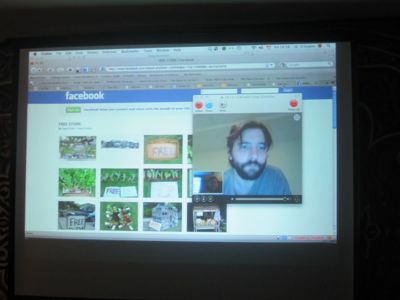
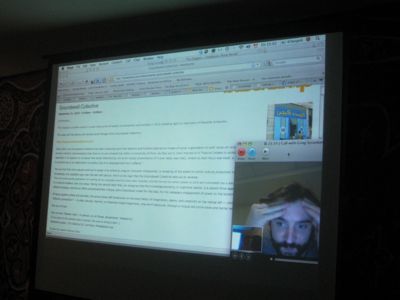
On Friday afternoon Stephen organized a seminar entitled ‘Machina multa minax minitatur maxima muris’, addressing the machine in contemporary society in regard to the human body being inseparable from the machine. Modernity defined machines in two different ways, a robot, an extension a prosthesis, a powerful tool, useful and celebrated device. On the other hand as replacing the human body and then perceived as a device of alienation. Those two apparently polarized conceptions of the machine have one fundamental point in common: a machine is not separate from the human body that operates it. Machines are not objects but subjects. Stephen hinged his lecture on modern machines by explaining Fordism, post Fordism and Animism with excerpts from videos like ‘Worker Leaving the Factory’ by Harun Farocki, as well as Angela Melitopoulos & Maurizio Lazaratto’s ‘Assemblages’, from the show Animism curated by Anselm Franke at Extra City and Au Travail(At Work) by Dominic Gagnon. Also cited was the text by Sean Dockray ‘The Scan and the Export’, describing the machines themselves and the people who use them, referencing Deleuze and Guattari ‘desiring machines’.
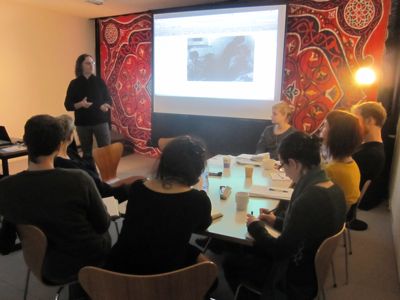
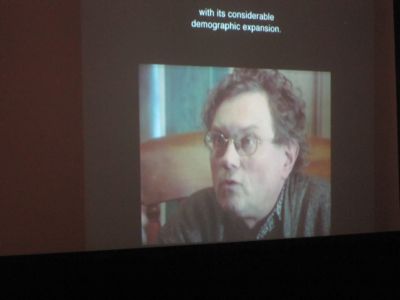
Machina multa minax minitatur maxima muris
How’s that for a lilting verbal readymade? “Mega machines that menace walls and ramparts to the max.” Cut & pasted from Roman military strategist Ennius (2nd C. BC), it happens to be one of the first instances of what would become the Latin usage of “machine”. Wouldn’t it make a nice epitaph for what so much politically engaged modernist and contemporary art sees itself to be doing? Breaking down semiotic walls, or better still, melting them away, circumventing them by displacing the partition lines of the sensible? But more importantly, this premodern usage of the notion of machine reveals to just what extent modernity “instrumentalized” the notion of the machine, construing it either as an alienating replacement of the human, or else a mere extension of human agency. What has become clear under post-Fordism and the rise of 2.0 attention economics is the extent to which machines are not mere objects, but subjects — or rather to what extent subjectivities and their production are inseparable from giant machines, from networks of hybrid machinery, from the desiring machines that we are. Animism, anathema to modernity, may be making a comeback. The walls that have been broken down are those of the factories — those icons of modern productivism — yet if the factories are no longer visible, they have not disappeared, but have become socialized — and their immateriality continues to produce value, desire, relationality, profit. The shadows previously cast by the walls have shifted, by which we mean that working conditions have changed dramatically, and yet we struggle to describe this shift with the conceptual vocabulary of modernity. But artists are showing a different picture — and in this era where language stutters to articulate the change, it is interesting to see what artists have been filming behind the invisible factory walls, in the new shadows cast by the pulsing of the overcoded networks.

